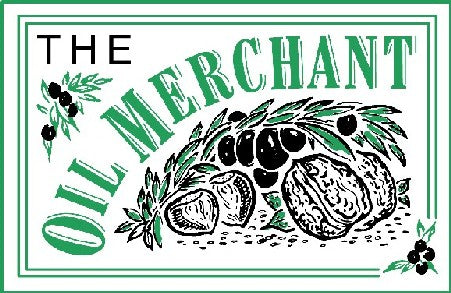Extra Virgin Olive Oil
Olive oil is divided into two main categories – virgin olive oils and simply olive oil. The first are pressed directly from the olive and then are sold as they are – essentially olive juice in which the oil and water are separated, nowadays generally using a centrifugal system. The second category, ‘olive oil’, is a blend of refined olive oil, which has been obtained using heat, pressure and chemicals, and some virgin oil, which is added to give a little flavour. This is useful in cooking, for example frying or making mayonnaise, where you need a bland base to work with.
To be classed as virgin an olive oil must pass organoleptic testing (checking the taste, aroma and visual appearance), and have an oleic acid content of less than 3%. To be classified as extra virgin the oil will have an oleic acid content of less than 0.8%. This is an indicator of the structural strength of the oil – the lower the acidity, the better the olives have been treated on the tree and at harvest.
Single-Estate Extra Virgin Olive Oil
Most good-quality, estate-bottled olive oils have an acidity of no more than 0.4%. Great care will have been taken in the growing, picking and pressing of the olives, and a small producer will ensure that the time between harvesting and pressing the fruit is minimal to maintain the olives’ peak condition and avoid the process of oxidisation starting.
Estate-bottled EVOOs are the equivalent of Chateau-bottled wines. The importers know the farms from which they come, and the people who have grown the olives and produced the oil. They know the varieties of olives from which the oils were made. They understand that these oils can vary from year to year, just as good wines do, and certainly that they will vary from region to region. Some might be soft and buttery, some might be assertive, herbaceous and peppery. These oils are usually used in simple vinaigrettes where the quality of the oil is the most important factor, for example mixed with just a squeeze of lemon juice. They are also perfect for finishing dishes: a light oil over some grilled fish or with a lamb’s lettuce salad, a strong one over a steak, a medium one over steamed asparagus. Not just a cooking medium, good extra virgin olive oil can, and should, be used as a seasoning, adding layers of flavour and intensity to food.
Supermarket own-label or mass-produced branded EVOOs are generally a blend of oils bought and sold on the international commodities market, meaning that the oils will have come from different regions and will usually vary in quality and flavour, but will be blended to meet the specific style and price point a buyer or commercial brand is looking for. Flavours will not vary greatly from year to year, and will not express ‘terroir’ in the same way a bottle of estate oil does, but they have their uses for general cooking and for making assertively flavoured dressings where the oil should not be the most prominent ingredient.
Olive-Oil-Growing Countries
Most of the oils that we sell still come from the Mediterranean basin, but over the years the production of extra virgin olive oil has expanded from the typical countries of Italy, Spain, Greece, France and Portugal to cover many other regions across the northern and southern hemispheres – for example California, Australia and Tunisia are all producing top-quality olive oils nowadays. Indeed, the landscape of Somerset West, in South Africa, is ideally suited to producing an Italian style of oil, which the estate of Morgenster has done since the 1990s – using trees imported from Italy – to much acclaim and continued success.
It is possible to identify typical flavour profiles from the traditional olive-oil- producing countries, as each region will have its own varieties, climate and soil type; all of these, coupled with local harvesting and processing techniques, will affect the flavour of the oil produced. An unusual example of this is Castelines Noir d’Olive. This oil is made in the traditional manner of the Valle des Beaux, where olives are left to ferment slightly before being pressed, giving it an unusual (and technically faulty) flavour often likened to black olives, mushrooms and vanilla. This 'fault' means that it must be classed as virgin, not extra virgin, although such is the quality of this particular oil that the oleic acid analysis would clearly make it extra virgin.
While the oil produced by a specific region used to be dictated by what was grown locally, now, with over 400 varieties of olive in the world, serious growers can use research to identify which will work best in their soil and climate. More recently, some serious producers have taken to making single-variety oils to express the characteristics of certain olives, much as New World wine producers have been doing for decades
Health Benefits
Recent medical and scientific studies have analysed the Mediterranean diet, giving special attention to extra virgin olive oil. The nutritional combination of fatty acids and the anti-oxidant micro elements - which are only found in extra virgin olive oil - are showing massive nutritional health benefits including:
- The combination of olive oil and vegetables rich in nitrates produce nitro fatty acids, which can reduce blood pressure.
- The polyphenols found in extra virgin olive oil contain important antioxidant and anti-inflammatory functions which protect cells.
- Cooking fish in olive oil helps to protect the breakdown of heat-sensitive Omega-3 polyunsaturates.
- Eating olive oil with carbohydrates can decrease the absorption of sugar, reducing the glycemic load of a meal.
For further detailed information of the numerous health benefits of extra virgin olive oil, we highly recommend that you read “The Olive Oil Diet” by Judy Ridgway and Dr. Simon Poole.
Subscribe to our emails
Subscribe to our mailing list for insider news, product launches, and more.
